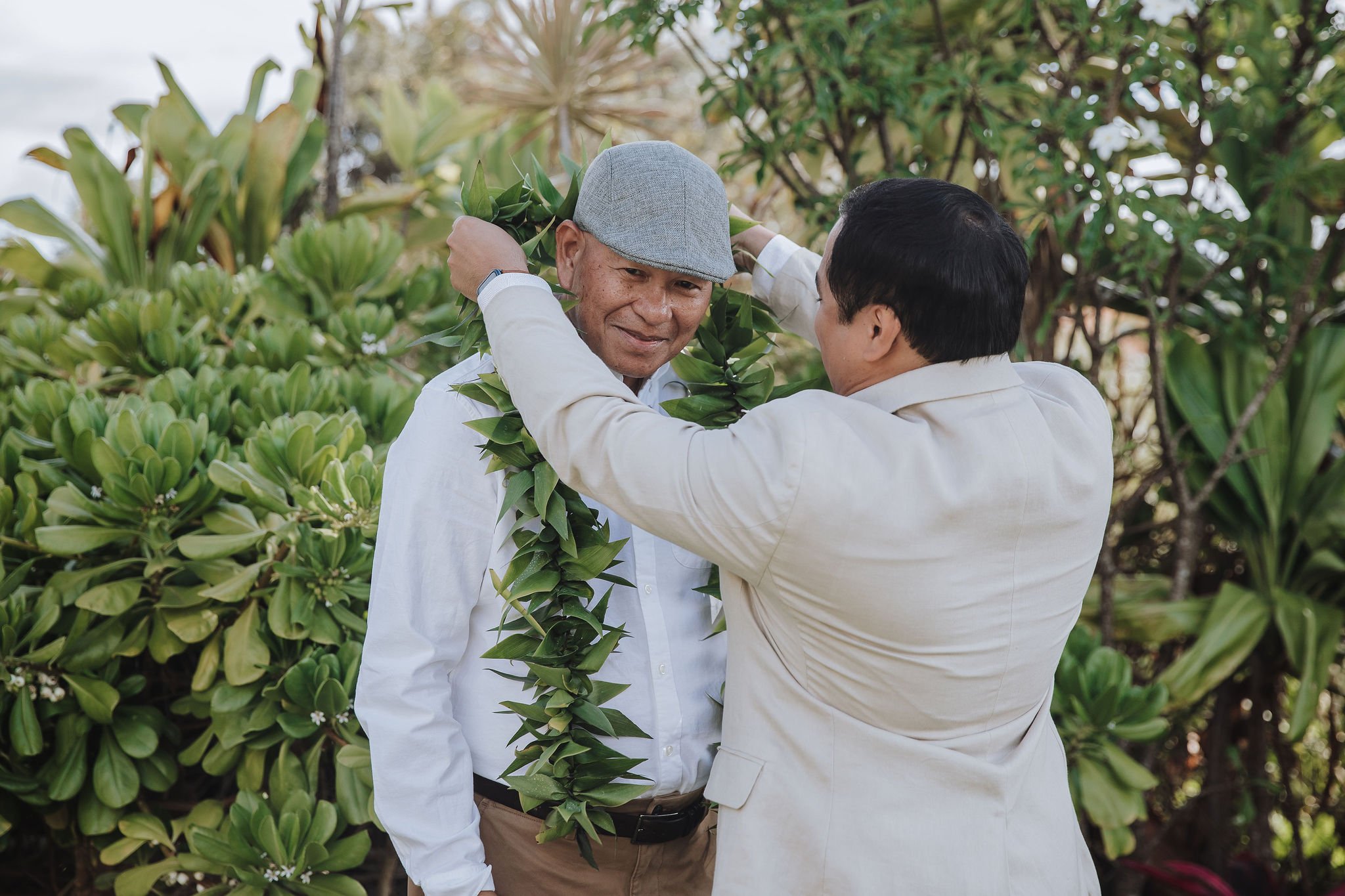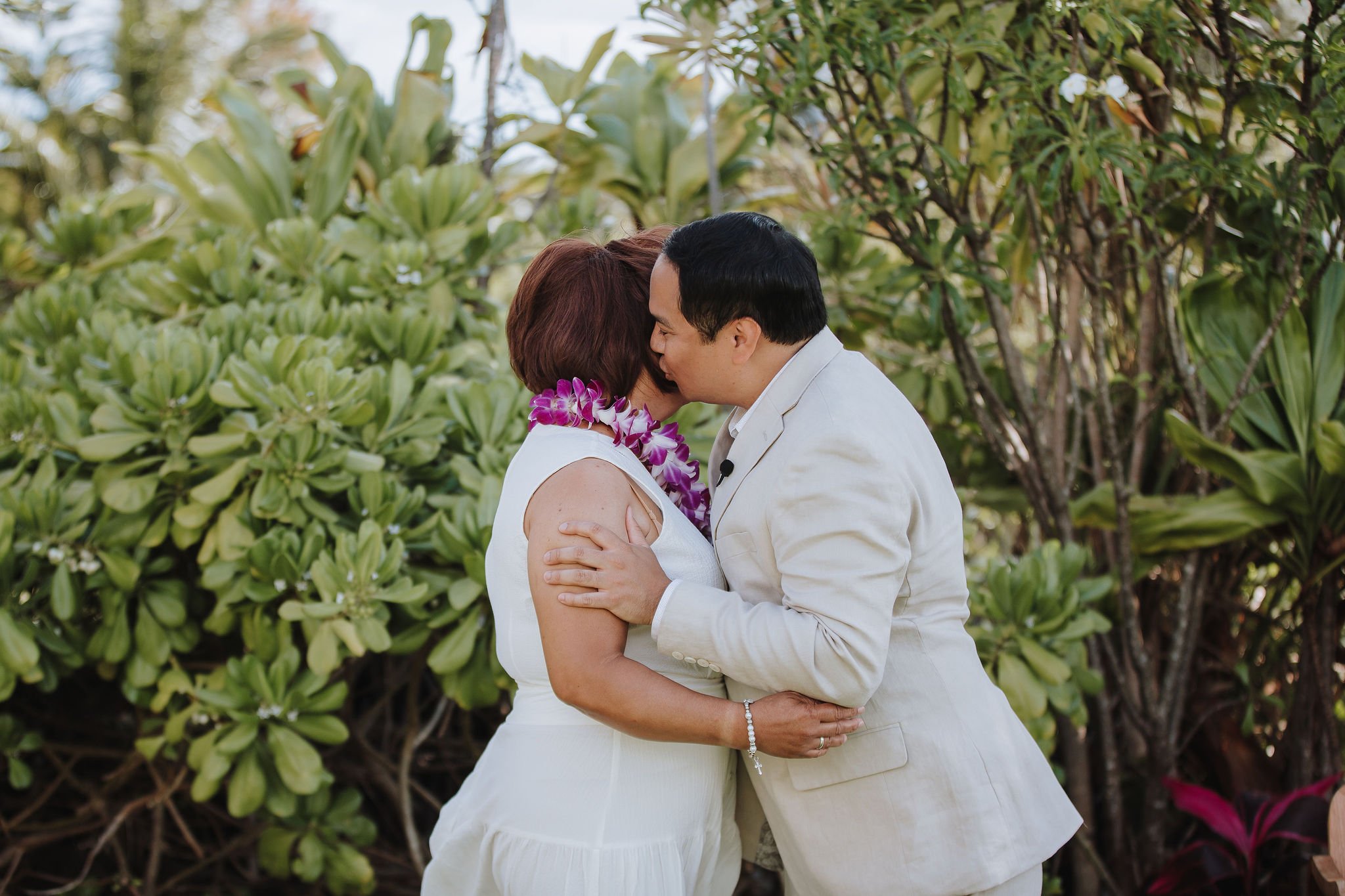We are so lucky to live in a place with such a diverse population! This diversity is often seen when attending weddings in Hawaii as many times couples will integrate their culture into the celebration! Though there are truly SOOO many different cultural traditions that we often see at Hawaii weddings, the following are just 8 of the most common traditions that we’ve seen. We love that couples choose to celebrate their heritage, or the Hawaiian culture, on their special day and we hope that weddings will continue to be a way for different families and cultures to be joined together by love!
Photography: Michele Coelho Photography
Lei Exchange
One of the most iconic symbols of the Aloha spirit is a lei. In Hawaiian culture, leis represent love, celebration, and of course Aloha! As we often see, leis are adorned on those we are celebrating. At weddings we not only tend to see leis worn by the couple but also on those that we are so incredibly grateful for, such as our close family & friends, even visitors who fly to the islands to celebrate the special day! Whether you choose to include a lei exchange in your ceremony or simply lei your loved ones on the big day, leis are a beautiful way to incorporate and honor Hawaiian culture into your wedding!
Want to include leis in your wedding but are not sure which style of flowers you should give to your family and friends? Have a chat with your florist to see which flowers will be in season at the time and what style they recommend for each person/group that you would like to lei
Origami Cranes
Photography: Rebecca Keizer Studios
A Japanese-American cultural tradition that we often see at local Hawaii weddings, is a display of origami cranes! Specifically 1,001 cranes made using origami paper, typically gold! The tradition stems from Japanese culture, in which the cranes represent longevity and good luck. Believed to live for 1,000 years the cranes can also be arranged and displayed as a larger picture (i.e arranged in the last name, an animal, heart, etc.). Traditionally, the bride will fold 1,000 cranes and the groom will fold 1! But I’m sure that’s something about this custom, that’s okay to change ;)
Photography: Anela Benavides | Officiant: Grant Gomes | Venue: Hawaii Vista Weddings
Blowing of the Pū
The Hawaiian conch shell, also known as the Pū, can often be heard at the start and end of a wedding ceremony. In Hawaiian culture the call of the Pū is believed to summon all four elements (air, fire, water, and earth). It’s commonly blown at weddings to invite the elements to be witnesses of the union, Pū-tting out the loving energy for the happy couple.
Tea Ceremony
Though there are many Asian cultures that include a Tea Ceremony in their wedding, the Tea Ceremony we are specially highlighting is the Chinese Tea Ceremony. This tradition gathers family members of both sides and allows the couple to serve their relatives tea as they receive wishes of good fortune, and gifts from their families. This bringing together of families shows that the bonds of marriage stem beyond two people, but is a marriage of families. The ceremony most typically is held prior to the western ceremony and is a way to bring both culture, family, and happiness to this special occasion.
Interested in learning more about the Chinese Tea Ceremony? Check out our blog sharing details on the traditional ceremony HERE!
Photography: Visionari
Hula
Photography: Seeking Films
Dating back to ancient Hawaiian times, the Hula is not only a way of dancing but it was seen as a way to tell history and stories. This Hawaiian dance is often performed at weddings by the bride to the groom or by hired dancers, during the reception program. Having a Hula performance at your wedding is a truly beautiful way to show your love and to honor the Hawaiian culture.
Money Dance
Similar to the Tea Ceremony, many cultures have a Money Dance tradition tied to their heritage. Though the Money Dance may be performed a little differently in each culture, the performance generally involves the couple dancing with or for their guests as their guests shower them with money. This custom is a way for the couple to feel the love and support they have from their family and friends as they begin their new lives together!
Photography: Aria Studios
Banzai Toast
Photography: VIVIDfotos
If you’re at a local wedding there’s a likely chance that you’ll hear someone hear someone ask you to raise your glass and shout "BANZAI!" three times! This chant that can often be heard at local Japanese weddings, is known as the Banzai toast! The cheer is typically conducted by a speaker yelling Banzai and the guests repeating it three times, each time getting louder and louder! As the term is believed to mean 10,000 years of life, the toast is often conducted twice in order to wish both the newlyweds and their guests 10,000 years of life! So the next time you're at a wedding and hear this toast make sure you shout back with a great "BANZAI!"
Want to see the Banzai toast in action? Check out our blog sharing a video of this toast and details on how you can do it at your wedding HERE!
Lion Dance
In Chinese culture, the performance of the Lion Dance symbolizes happiness and good fortune! It’s often performed at local weddings as it is a way to bless the couple and wish them a long and happy marriage! Not only will the Chinese Lion scare away evil spirits from getting to the newlyweds, but they will also definitely entertain all of your guests! So if you’re going to be attending a Hawaii wedding soon, make sure to bring a few extra dollars so that just in case a lion dance is performed you can feed the lion! TIP: Either have dollar bills to give your guests to feed the lion OR let them know in advance they may want to bring cash if they want to participate in this specific tradition :-) !
Photography: Derek Wong Photography
Though these 8 cultural traditions are ones that we see most often at weddings, if there’s a custom that you want to include in your special day, we definitely recommend letting your coordinator know as soon as possible so that they can help you create a ceremony or reception timeline that will perfectly showcase your cultural tradition.
XOXOXO
Happy Planning!
(A Perfect Day)









